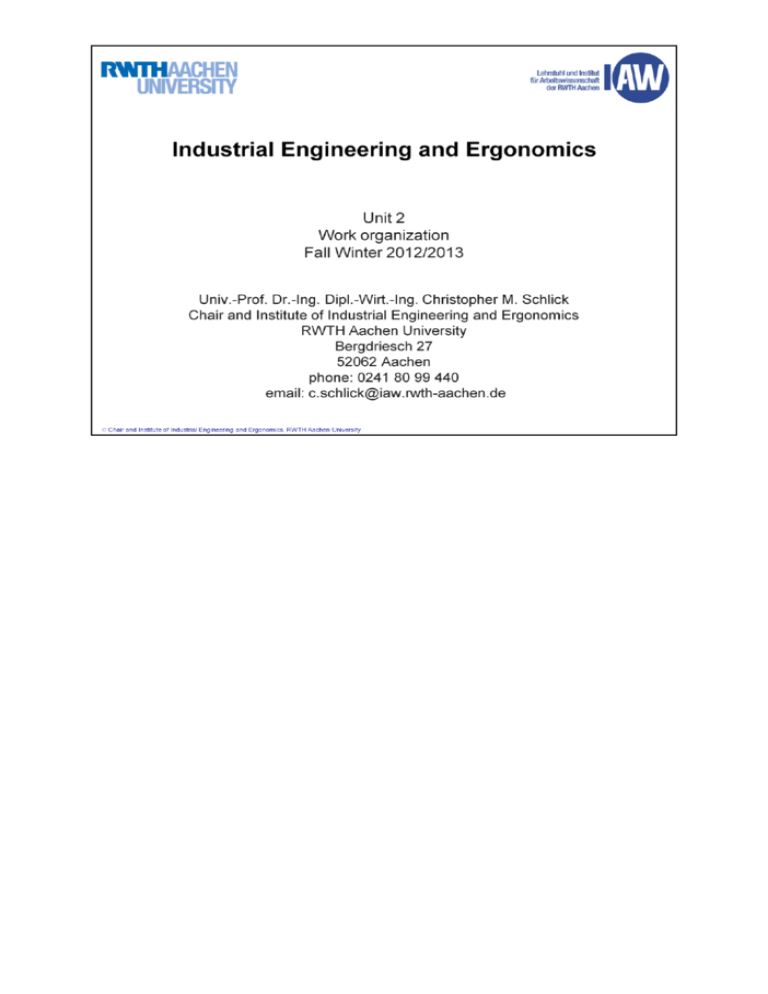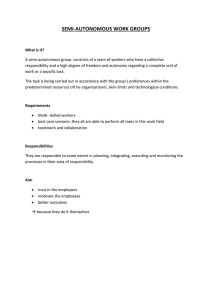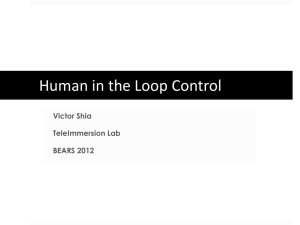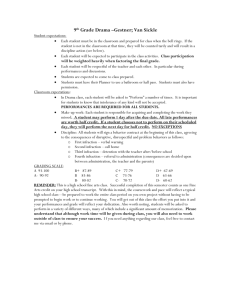Download: Skript 2
advertisement

Work organization in the ancient world was based on the addition and multiplication principles without any work studies taking place. First experimental work studies were conducted by Leonardo da Vinci and were increasingly systemized during the course of development. Probably the most well known example in early modern times is the study of the division of labor by Adam Smith. According to Adam Smith, the division of labor increases work productivity. The specialization then promotes the individual worker‘s skillfulness in the task given to him/her. Associated with this is the time saved in production. The specialization also leads to technical advances since the work tools would also be specialized. The time saved due to work division can be enormous, as Smith explains in an example: A single unskilled worker can only produce a small amount of pins in one day. If the task is assigned to several workers, each of which must carry out only a few hand movements – one pulls the wire through a hole to achieve the desired strength of the pin, another to tweak the wire in short pieces, a third to sharpen all the pieces, a fourth places a head on its top and a fifth packages the pins. According to Smith, following this method, five workers can produce thousands of pins in one day. The origins of ergonomics can be traced back to Frederick Winslow Taylor (1856–1915) and his student, Frank Bunker Gilbreth (1868–1924). Both investigated the work processes of workers with the goal of optimization. Taylor assumed that the observance of the best worker would make it possible to create the optimal process. Ransom Eli Olds already used wooden stand in 1902 for the production of his “Oldsmobile”, on which the cars were pulled to different manufacturing stations. In 1913 Henry Ford refined the production by implementing an assembly line instead of the wooden stand. The workers were then compensated by Ford according to how quickly they could execute specific mechanical work steps. An early model of semi-autonomous group work was achieved by Volvo in the beginning of the 1970’s in a factory in which the complete responsibility of manufacturing entire automobiles was transferred to worker groups for the first time. The term Business Process Reengineering was coined by Michael Hammer and James Champy in 1993. In contrast to business process optimization in which only single business processes are effectively designed, a fundamental reconsideration of the business and its business processes takes place here. Simultaneous Engineering - (also called Concurrent Engineering) identifies a technical development process. With this process the development time of a new product is to be reduced, future product alterations avoided, and the agreement between development and production improved. This economic state lead to a Renaissance of group work, particularly at the end of the last century. Humanization measures were/are no longer the focus, as they were in the 60’s and 70’s; instead, productivity advantages in comparison to individual work are the focus. The increasing globalization and consequent global competition supports value-added networks. The macro level describes the organization of an entire enterprise and/ or plant. Furthermore such a company can be part of an inter-organizational network. This is summarized by the term operational organization or network-organization (7th level). The enterprise level (6th level) includes legally separate companies, possibly running in multiple locations in Germany, Europe and the world. Each of these plants (5th level) incorporate organizational structures, which are clearly defined (4th level) as work team (3th level), work place (2nd level), and job/ function (1st level). On the departmental and group level (meso-level) work organization take place in a broader sense, i.e. the actions of individual coworkers are coordinated. On the micro-level a narrower definition of work organization exists since partial actions of an individual are coordinated here for the completion of the work task. Example: The VIA-Network (Network of innovative automotive suppliers) is a cooperation between companies that mainly supply metal structures for the automotive industry and in some cases jointly produce and offer their products (7th level). Each network partner is a legally independent company (6th level) with partly several plants in Germany and Europe (Plant level). Each plant has its own organizational structure on the level of divisions, work teams, work places and the respective tasks. The overall objective of enterprise and work organization is the planning, shaping, directing and continuous improvement of work systems in a productive, efficient and humanly appropriate manner. Work productivity and the utilization of working capital, for example, count among the more economic objective criteria. Among a rather more human-oriented targets include for example the motivation and healthpromoting work design. In the past 15 years, flexibility has gained more importance in the context of the development of modern forms of the work organization. The latter is often designated as third worthy dimension. Consequently, work systems have to be able e.g. flexible enough to react to fluctuating capacitive strains (i.e. short-termed fluctuation of order or failures in the operating procedure). Processes and structures as well as labour employment or rather employees are affected by the demand of flexibility. The goal of flexibility regarding the so called new forms of work organization (NFWO) is achieved with the help of self-controlling and autonomous sectors involving scopes for making a decision (i.e. Decisions concerning the succession of orders to be executed or the occupancy of machines with production orders) and scope of action (e.g. employees taking over various tasks). The System Engineering Concept is based on an interdisciplinary foundation with the goal of developing and realizing complex systems efficiently. The focus is on the functionalities of the (work) system that is to be developed. In particular, the design, structure and the behavior of a work system belong to these functionalities. In connection with the respective project management, the system design aims at securing the system through a design synthesis and system evaluation. Special attention must thereby be paid to the overall problem (organization, costs, schedule, performance, advanced training and support, testing, production and reuse). The Systems Engineering approach integrates all of these engineering disciplines and capabilities in one uniform, team-oriented, structured process. This process is used in product development, production planning and series production launch, and all the way to production; in some cases, even up to the dismantling and reuse phase. Ideally, Systems Engineering takes into account technical and economic requirements with the goal of providing the customer with a product fitting his/her expectations. Task analysis is the systematic screening of the tasks to be distributed with the aim of being able to accomplish the tasks in an orderly manner (Schreyögg 2003). The task analysis is based on the overall mission of a company. The overall mission can be segmented according to certain criteria through a multi-level analysis into specific sub-tasks, which enables a more accurate comprehension of it. The task analysis is elaborated using the following five dimensions (Kosiol 1976): 1. Performance analysis is the extraction of sub-tasks according to their related functions (e.g. sawing, sanding, hammering). Each function should be broken down until the level of elementary function (sub performances of lowest order) is reached. 2. Object analysis covers object related performance processes such as products to be handled. 3. Rank analysis means the subdivision of tasks in execution and decision-making tasks. A decision-making task in a production process is for example the placing of an order; the execution is carrying out the order. 4. During phase analysis, sub-tasks are formed according to the three phases of planning, implementation and monitoring. 5. The aim of the function relations analysis is the arranging of tasks according to their position in the performance process. A differentiation is made into direct (immediate value) and indirect (gradual value) tasks (Schreyögg 2003). According to the performance principle, during task synthesis, subtasks (here: sawing – employee A; turning – employee B) that present similar performances to different objects are comprised in task complexes and assigned to a workplace. According to the object principle, during task synthesis, the available subtasks that present different performances to similar objects, are comprised in task complexes and assigned to a location. In detail, three cases can be distinguished with regard to the object: 1. Or-object structure: Is used when there are numerous, not mutually exclusive options of object-oriented structure. 2. And-object structure: Is used to describe conditions to be fulfilled conjunctively in a formal manner. 3. Either-or structure: Is used when mutually exclusive options for separation exist. The operational target planning sets the goals to be achieved in the form of data. The planning of the process describes the tasks and their sequence required to reach the goals. The planning of means specifies the system elements needed for the execution of tasks. The results of the planning of means are, for example, parts lists, personnel requirements plans and capital spending plans. Aside from the setting of the degree of centralization, the issues of task distribution in the hierarchy, the delegation of responsibility/decision making authority and competence must be taken into consideration. The higher the level of centralization, the less autarkic the employees are in their decision scope. The tasks of the superiors are therefore increasingly of an coordinating nature as the degree of centralization decreases. Job Enlargement An extension of previous tasks with qualitatively equivalent tasks, which often occur prior or after the previous tasks within the product/performance process. Job Enrichment The range of duties is expanded through tasks that were previously assigned to a higher hierarchical level while also being qualitatively more important and demanding. Work functions placed before, during or after, as well as planning, steering and workshop directing tasks are integrated. An employee’s discretionary powers and room for maneuver are expanded through an increase in decision, execution and responsibility competences. Job Rotation Within job rotation the scope of the individual work position as well as the degree of labor division remains unchanged. The extension of work for the single person results from the systematic change between several work positions. As a result, the monotony of the work is decreased and the employees can be more flexibly deployed. The extent of the positive effects depend essentially on the job profile of the work tasks or positions included into the rotation. Work structuring measures design work in the required and development promoting manner. This is achieved through holistic work contents (reduction of departmental depth in order to achieve a longer involvement in the production process), dynamic work design (change of existing, and acquisition of new, work systems related to the personal development of the worker), differential work design (availability of various work systems that workers can choose from) and participative work design (employees can become involved in the design of the work system and the work contents). Design goals can be achieved in a work organization manner through the help of Job Enlargement, Job Enrichment and Job Rotation. Group work is a label for heterogeneous models of work organization with quite differing goals (Rhine 2002). As opposed to individual work and other cooperative forms of work (e.g., Tandem) group work refers to a form of work organization, characterized by the fact that a work order will be assigned to more than two persons, who (re)define and interpret it as a co-working task, and is finally processed in cooperation (Schlick et al. 2009). Direct, contract-cooperation in the strict sense of team work is given when a reciprocal task context between the group members exists. An example is the product development within a project group: The joint development contract is broken down into interdependent sub-tasks, which can be processed simultaneously (parallel). The existing dependencies require continuous adjustments (communication) (ebd.). From different disciplines and application fields further requirements come onto group work: In the context of industrial production are for example constituent characteristics of skilled, semi-autonomous group work, a common core task, which include planning, organization and control functions, as well as an extensive self-governance through the work group required (see Gohde and Kötter 1990). In social psychological influenced definitions further requirements are formulated towards working group. “Real" working groups for example require that its members remain in direct interaction for longer periods, experience themselves as belonging together ( "we“ feeling "), and its environment recognizes the members as a group (Wegge 2004). Key characteristics of group work (minimal requirements) are according to Hacker (1994): 1) a common, separately executable order/contract for more than two persons, which requires 2) a joint action organization to accomplish the order, and thus 3) joint decisions on the basis of temporal and on content scope of action for the group. For coordination and task scope organization further 4) communication and 5) a minimum of commonly shared goals and knowledge – among other things about the work order/contract, appropriate procedures, the work objectives, work tools, and about the work behavior of the partner – are required. The achievement of different goals is sought through group work: Companies will become more flexible, particularly in work order processing, through the self-directing of decentralized units; the result is that companies can then focus more strongly on specific customer needs The extensive decision-making and management competences of groups will allow them to independently make improvements. Cycle times and supply will be reduced as a result, and interfaces will be optimized. An improvement in working conditions will be reached through greater time scopes and the broadening of scopes of action for the employees. At the same time, the motivation of employees will also be improved. (cp. Kühl / Kullman 2002:8) In the numerous publications and cases regarding group work, two main categories of goals can be identified (economic and humanitarian); these were, for example, also compiled by Wegge (2004: 18). Forms of group work can be roughly divided, on the nature of their organizational anchoring, into two categories (see chart). Examples of the first category are: Semi-autonomous work groups, whose members permanently work together for example in so-called "islands”, in order to create a complete product or sub product or a complete service largely independently. Lean-groups/-teams or production teams durably work together in a flow association (assembly line) and usually are responsible for a certain section of the process. In comparison to semi-autonomous work groups, lean teams, strongly influenced by Toyota, are embedded in a strict hierarchy and possess less task and decisionmaking scope. Classical work groups, which are organized through task/function and labor division, are also assigned to this category. The group members are subordinate to a supervisor and work according to his instructions. All the planning, managing and controlling functions take place centralized. Since group members of classical work groups perform largely independent tasks, they do not fulfilling the minimum requirements of group work (Antoni 2000). The second category includes for example: project groups/-teams that are temporarily formed to work on rather complex tasks and usually composed of experts from various disciplines. The duration of the cooperation is limited by the achievement of predetermined targets or deadlines. Quality circles and CIP groups (CIP = Continuous Improvement Process), which deal with the resolution of quality problems and the search for technical or processimprovement potentials. Other examples are health circles in which members deal with issues of health and ergonomic work (space) design, as well as learning islands within e.g. trainees of the same field work together on "real" contracts/jobs. During sequential or performance-oriented manufacturing, the object (e.g., an automobile) is transported along an assembly line or similar type of transport system. Diverse workplaces are ordered along the material flow, whereby workers perform time-coordinated performances or with the help of machines so that intermediate buffers are almost entirely eliminated. The object to be completed “flows” from one station to another according to a predefined sequence before it leaves the production process. The object is assembled by a responsible semi-autonomous work group during object-oriented manufacturing. A timed material flow between work groups generally does not exist. Explanation of figure: Loading of shopping baskets occurs as group work carried out by employees Shopping baskets are loaded for the assembly of exactly one automobile Each component has a set spot that is defined through inlays Assembly order is thereby given The components are numbered to achieve an overview of which parts have already been installed. Assembly is complete once the shopping basket is empty. Routes are reduced and process security is increased As a result, Audi also contributes to demographic change. Concurrent Engineering (CE) is also referred to as Simultaneous Engineering (SE). Concurrent Engineering is the integrated and temporally parallel execution of product and process design activities. This organizational concepts aim at the inclusion of all affected areas, from conception to construction, production and the implementation of a product all the way to disposal. The goals of CE are mainly to decrease product development times while at the same time improving product quality and lowering manufacturing costs. These goals are to be achieved through an improvement in the level of attention paid to mutual demands and the beginning of activities as early as possible. (cp. Luczak, H.: Arbeitswissenschaft (1998), p. 523ff). Characteristics of Concurrent Engineering (CE) Teams: small functional/organizational unit of the regular organizational structure 5 to 15 persons creation of a complete (partial) product or a service occurs primarily under one’s own responsibility (according to the self-regulation principle). team works under time pressure in close coordination with one another higher degree of autonomy and personal responsibility for a joint task the team is jointly responsible for the result of a task, i.e., also accounting for any errors CE shortens integrated product and process design the business has an advantage over the competition since the products go to market earlier Today, all large automobile manufacturers work with Concurrent Engineering. CE teams make it possible to achieve both economic as well as person-oriented goals in process and product design. (cp. e.g., Kabel 2001) The CE team‘s goals can be reached in a work organizational manner. Within these teams, synchronization and parallelization of the process under consensus of all involved can be achieved through close cooperative relationships. Time potentials will be used with sequential product and processing planning in both the integrated as well as the parallel execution of activities. This will lead to reduced development time. The goal of the integration of individual activities into an entire product and the processing planning activities are the collective consideration of mutual restrictions while simultaneously reducing the communication and coordination effort through the reduction of interfaces. However, there are limitations to the integration since the complexity of activity execution increases with an increase in integrated activities. If activities can no longer be integrated due to the high level of complexity, they must be parallelized in the sense of CE to allow for an early mutual consideration of restrictions. This, in turn, leads to a higher level of communication and coordination efforts due to the necessary coordination process (Stahl 1998). The introduction of group work oriented concepts in indirect business areas requires different areas of emphasis other than the introduction of group work to manufacturing. This fact is based on the non-value-adding planning tasks in the indirect areas. The identification of employees with their work in the production of almost non-material services is not as attainable as in the production of visible complete products in the direct areas. The potentials of indirect areas can be uncovered and used through the implementation of suitable methods that were adapted to area-specific factors. Worker motivation is increased in indirect areas through expanded room for maneuver, social integration into a group and a performance-based remuneration scheme. Furthermore, due to the greater number of interfaces, departmental and business-spanning cooperations occur. These different department and business cultures clash with one another (cp. Luczak, H.: Arbeitswissenschaft (1998), p. 525). CE teams dissolve after a project‘s completion and are later again pulled together for new projects. Groups (or, for example, planning islands) are permanently integrated into the organization. Semi-autonomous groups (also planning islands) are permanently integrated into the organization and therefore display fixed organizational boundaries. Aside from fluctuations that are not related to the task (e.g., retirement due to age), the personnel composition does not change. A variety of different orders/projects are processed. In contrast, CE teams are formed only for a specific project. The organizational boundaries are open. Generally, a so-called core team is set up that is strengthened by employees from different business areas (if needed, even by external employees, e.g., from suppliers) depending on need. CE teams dissolve again after a project's completion.







